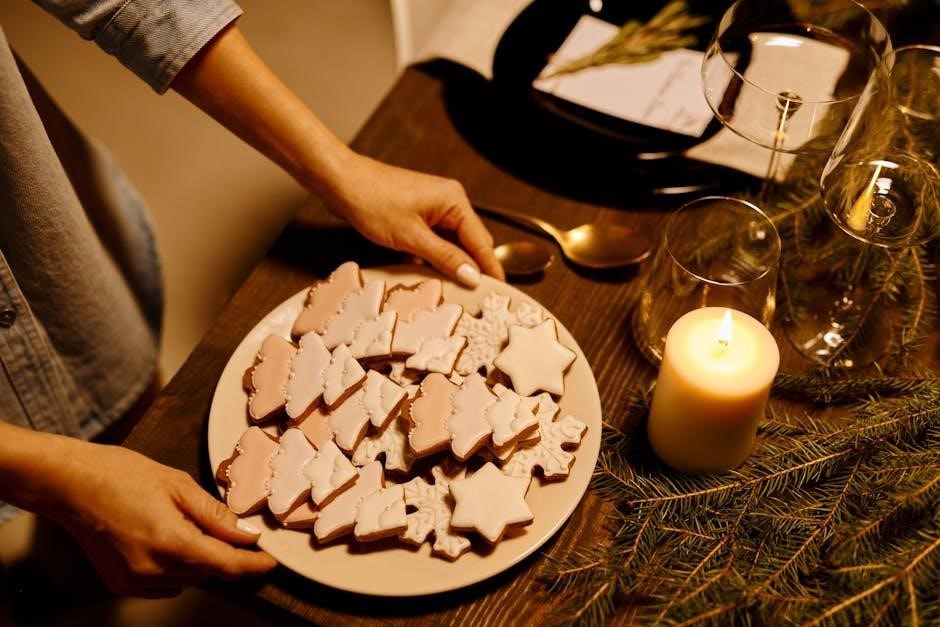Understanding cake serving sizes is crucial for planning events, ensuring every guest enjoys a satisfying portion. This guide covers standard sizes, slice dimensions, and factors like layer thickness to help you calculate servings accurately for parties, weddings, or any celebration.
Overview of Standard Cake Serving Sizes
Standard cake serving sizes are typically based on 1×2-inch slices for party portions and slightly smaller for wedding portions. A 6-inch cake serves 12-20 people, while an 8-inch serves 20-32, and a 10-inch serves 36. The number of servings depends on cake height and layers, with a 4-inch tall cake (two 2-inch layers) as the baseline. Each additional layer increases servings by half. Party slices are generally 1.5 inches wide, while wedding slices are narrower, around 1 inch wide. These guidelines help ensure accurate planning and portioning for events, making it easier to accommodate all guests.
Importance of Accurate Serving Size Calculations
Accurate serving size calculations ensure every guest receives a consistent portion, avoiding waste or disappointment. Proper sizing guarantees enough cake for your event, balancing taste and presentation. It also helps in budgeting ingredients and resources, preventing over-preparation or underestimation. Correct calculations are vital for both small gatherings and large events like weddings, where precise planning is key. By using standard guides, you can adjust for variations in slice width and cake height, ensuring satisfaction for all attendees. This attention to detail enhances the overall experience, making your event memorable and well-organized.
Understanding Party vs. Wedding Cake Servings
Party cakes offer larger slices, while wedding cakes feature smaller, more formal portions. This difference impacts serving counts, ensuring the right fit for your event’s needs.
Standard Party Serving Sizes
Standard party serving sizes are designed to provide generous portions for casual gatherings. A typical party slice is 1.5 inches wide, offering a hearty serving. For round cakes, a 6-inch serves 12, an 8-inch serves 20-24, a 10-inch serves 36, and a 12-inch serves 48. These sizes ensure ample portions for guests, making them ideal for celebrations where larger slices are preferred. The wider slice width enhances the visual appeal and satisfaction of each serving, catering to the relaxed nature of party events.
Wedding Serving Sizes
Wedding serving sizes are smaller than party servings, typically measuring 1 inch wide, 2 inches long, and 4 inches tall. This smaller portion allows more guests to be served from the same cake. A 6-inch round wedding cake serves 20, while an 8-inch serves 32, and larger sizes scale accordingly. The narrower slices are ideal for formal events, ensuring every guest receives a portion without overwhelming them. This approach maximizes the number of servings while maintaining an elegant presentation, making it perfect for large gatherings and special celebrations where precision and portion control are essential.
Key Differences Between Party and Wedding Servings
The primary distinction lies in slice size and portion width. Party servings are typically 1.5 inches wide, catering to larger, more generous slices, while wedding servings are narrower at 1 inch wide. This difference allows wedding cakes to serve more guests, ideal for large events. Additionally, party slices are often thicker, focusing on richness, whereas wedding slices are more refined, emphasizing presentation. These variations ensure that each event type is appropriately accommodated, balancing guest numbers with portion satisfaction. Understanding these differences helps in planning accurately, ensuring every celebration meets its unique needs effectively.
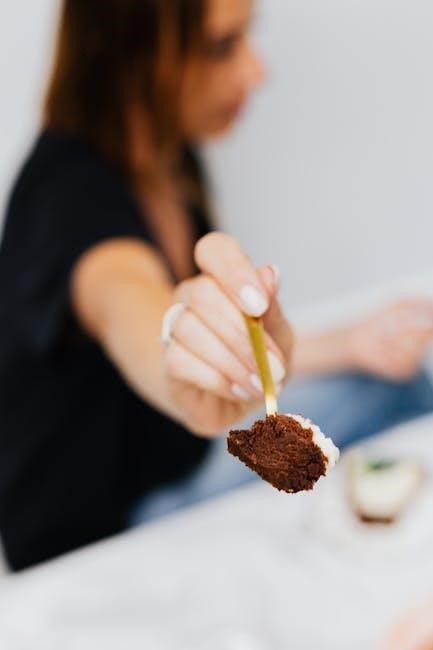
Round Cake Serving Chart
A round cake serving chart estimates servings based on cake size and layers. Standard charts assume a 4-inch tall cake with two layers, scaling servings with size and layers.
6-Inch Round Cake Servings
A 6-inch round cake typically serves 12 people for party-sized portions and up to 20 for wedding-sized portions. The cake’s height and layers also impact servings. A standard 4-inch tall cake with two layers provides 12 party servings or 20 wedding servings; Adding layers increases servings by half for each additional layer. For example, a three-layer cake serves 18 party portions or 30 wedding portions. Slice width varies, with party slices being wider (1.5 inches) and wedding slices narrower (1 inch). This size is ideal for small gatherings, offering a manageable number of servings without excess.
8-Inch Round Cake Servings
An 8-inch round cake serves approximately 20 people for party-sized portions and up to 32 for wedding-sized portions. The cake’s height and layers significantly influence the number of servings. A standard 4-inch tall cake with two layers provides 20 party servings or 32 wedding servings. Each additional layer increases servings by half. For instance, a three-layer cake offers 30 party servings or 48 wedding servings. Slice width differs, with party slices being 1.5 inches wide and wedding slices narrower at 1 inch. This size is perfect for medium-sized gatherings, ensuring ample servings without overwhelming the host. It balances convenience and generosity, making it a popular choice for events.
10-Inch and 12-Inch Round Cake Servings
A 10-inch round cake typically serves 36-40 guests for party portions and 40-48 for wedding portions. A 12-inch round cake serves 48-52 guests for parties and 60-65 for weddings. These larger sizes are ideal for bigger gatherings, offering generous servings without excess. The serving size assumes a standard 4-inch cake height, with each additional layer increasing servings by half. Party slices are 1.5 inches wide, while wedding slices are 1 inch wide. These sizes are versatile and popular for events requiring ample servings. They balance quantity and portion size, ensuring every guest enjoys a delicious treat at celebrations or formal events.
Sheet Cake Serving Guide
Sheet cakes are versatile, with standard sizes serving varying numbers of guests. Serving sizes depend on slice dimensions, typically 2×3 inches for thicker cakes or 3×3 inches for thinner ones, ensuring efficient portioning for events.
Standard Sheet Cake Sizes and Servings
Sheet cakes are available in standard sizes, including quarter, half, and full sheets. A quarter sheet typically serves 12-15 guests, while a half sheet serves 24-30. A full sheet cake serves 48-60 people. These sizes are ideal for large events, offering generous portions. The serving size is usually 2×3 inches for thicker cakes or 3×3 inches for thinner ones, ensuring consistent portions. This guide helps plan efficiently, whether for parties, weddings, or corporate events, by providing clear serving expectations based on cake dimensions and guest counts.
Thicker vs. Thinner Sheet Cake Portions
Sheet cake portion sizes vary based on thickness. Thicker cakes, often preferred for their moist texture, typically use smaller slices, such as 2×2 inches or 2×3 inches, reducing the number of servings. Thinner cakes, ideal for lighter desserts, allow for larger slices, like 3×3 inches, increasing the serving count. The choice between thicker and thinner portions depends on the event’s needs, with thicker cakes offering richness and thinner ones providing more servings. Understanding these differences helps in planning accurately, ensuring guests are satisfied without unnecessary waste.
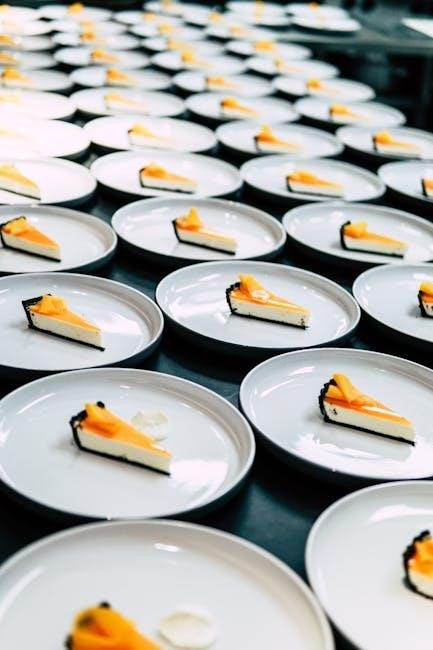
Tiered Cake Serving Guide
Tiered cakes add elegance to events, requiring precise serving calculations. Each tier’s size and layers affect total servings, with larger tiers offering more portions and smaller tiers fewer, ensuring a balanced and visually stunning dessert for your gathering.
Calculating Servings for Multi-Layer Cakes
Calculating servings for multi-layer cakes involves considering each tier’s dimensions and layers. A standard 4-inch tall, two-layer cake serves 8 people. Adding layers increases servings by half the base amount per additional layer. For example, a three-layer cake serves 12, and a four-layer serves 16. This method ensures accurate portion planning for events, allowing hosts to accommodate guests without waste. Understanding layer thickness and size helps in customizing cake servings effectively for any celebration, making multi-layer cakes both visually impressive and generously portioned.
Impact of Additional Layers on Servings
Additional layers significantly impact cake servings, as each layer adds volume and potential slices. A standard 4-inch tall, two-layer cake serves 8 people, while adding a third layer increases servings to 12. Each extra layer adds half the base serving amount, enabling more guests to be served. For example, a three-layer 8-inch cake serves 24, and a four-layer version serves 32. This scalability is crucial for event planning, allowing hosts to adjust cake size based on guest numbers. Understanding how layers affect servings ensures efficient portioning and avoids waste, making multi-layer cakes ideal for large celebrations.
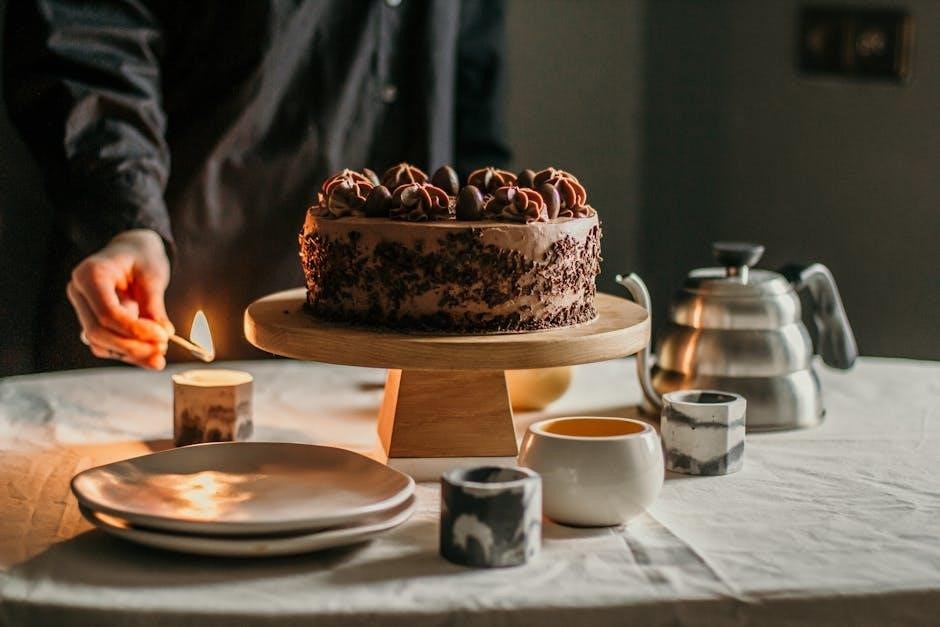
Tools for Calculating Cake Servings
Utilize tools like the Wilton Cake Serving Chart and dynamic cake serving calculators to estimate servings accurately for any cake size, shape, and layer configuration, ensuring perfect portioning.
Wilton Cake Serving Chart
The Wilton Cake Serving Chart is a trusted resource for determining portion sizes and calculating servings. It provides detailed guidelines based on cake dimensions, layer thickness, and event type. Whether you’re planning a wedding or a party, this chart helps estimate how many guests each cake size can serve. It distinguishes between party servings, typically larger slices, and wedding servings, which are smaller and more precise. By referencing the Wilton chart, you can ensure accurate serving calculations, avoiding waste or shortages. Its simplicity makes it an essential tool for bakers and event planners alike, guaranteeing perfectly portioned desserts every time.
Dynamic Cake Serving Charts for Custom Sizes
Dynamic cake serving charts offer flexibility for custom-sized cakes, allowing users to input specific dimensions and calculate servings. These tools are ideal for unique cake designs or non-standard shapes. By adjusting variables like cake height, width, and slice size, you can easily determine the number of portions. This feature is particularly useful for professional bakers and DIY enthusiasts alike. The charts often include options to differentiate between party and wedding servings, ensuring accurate portioning. With dynamic charts, you can plan perfectly for any event, whether it’s a small gathering or a grand celebration, ensuring every guest enjoys a consistent and satisfying slice.
Factors Affecting Serving Sizes
Slice width, cake height, and number of layers significantly impact serving sizes. Taller cakes or additional layers increase portions, while narrower slices reduce serving numbers. These elements must be carefully considered for accurate planning.
Slice Width and Serving Size
Slice width plays a key role in determining serving sizes. A wider slice increases portion size, reducing the total number of servings. Party cakes often use slices 1.5 inches wide, while wedding cakes use narrower slices, typically 1 inch wide. The width directly impacts how many guests can be served from a single cake. For example, a 6-inch round cake with 1-inch slices serves about 12 people, while narrower slices can increase the serving count. This variation is crucial for event planning, ensuring the right balance between portion size and guest numbers. Accurate slice width calculation helps avoid waste and ensures everyone is served adequately.
Cake Height and Layer Thickness
Cake height and layer thickness significantly affect serving sizes. Taller cakes or those with multiple layers provide more servings. A standard 4-inch tall cake (two 2-inch layers) offers a specific number of servings, while additional layers increase the total. Each layer adds depth, allowing for more slices. For instance, a 4-inch round cake with three layers serves 12 people, compared to 8 servings for two layers. This factor is vital for tiered cakes, where each layer’s height and thickness must be considered separately. Adjusting layer sizes ensures consistent portion control and meets guest demands without excess or shortage, making it a key consideration in cake planning and serving strategies.
Number of Layers and Their Impact
Number of layers directly influences the total servings a cake can provide. Each additional layer increases the cake’s height and depth, allowing for more slices. For example, a 4-inch round cake with two layers serves 8, while three layers serve 12, and four layers serve 16. This pattern shows that each layer adds half the number of servings of the previous layer. The impact of layers is crucial for tiered cakes, where each tier’s layer count must be calculated separately. Understanding this relationship ensures accurate serving estimates and helps in planning cakes for events with varying guest numbers, avoiding shortages or excess cake.
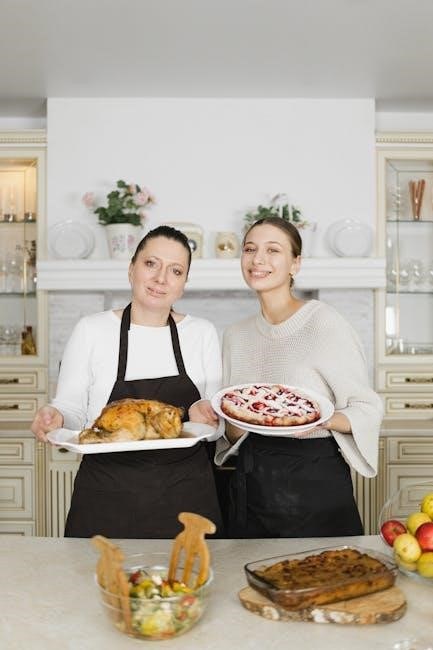
Special Considerations
Single-serving cakes offer a unique alternative for intimate gatherings or portion control. They ensure each guest receives an individual treat, perfect for special events or personalized celebrations.
Serving Sizes for Different Events
When planning events, serving sizes vary based on the occasion. For parties, slices are typically larger, around 1.5 inches wide, to satisfy guests’ appetites. Weddings often use smaller slices, about 1 inch wide, allowing more servings from the same cake. This distinction ensures efficient portioning for large gatherings. Additionally, the number of layers in a cake impacts serving counts, with each extra layer increasing the total servings. Understanding these differences is key to ensuring every guest receives an appropriately sized portion, whether it’s a casual celebration or a formal event. Precise planning guarantees a memorable experience for all attendees.
Single-Serving Cakes
Single-serving cakes, often called “baby cakes,” are perfect for intimate gatherings or households with fewer members. These small, individual treats typically measure 3-4 inches in diameter, ensuring each guest receives a generous yet personal portion. They eliminate the need for slicing and offer a charming presentation, making them ideal for modern celebrations. Despite their smaller size, single-serving cakes can still be elaborately decorated, maintaining the elegance of traditional cakes. This trend caters to evolving preferences, providing convenience without compromising on taste or aesthetics. They are especially popular in today’s smaller households, where larger cakes might go uneaten, and are a delightful conversation piece for any event.
